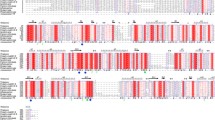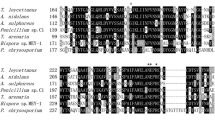Abstract
Using degenerate polymerase chain reaction (PCR), thermal asymmetric interlaced (TAIL)-PCR, and reverse transcription (RT)-PCR techniques, a new β-mannanase gene, denoted as man5C6, was obtained from Penicillium sp. C6. The gene has an open reading frame of 1,155 bp, and codes for a polypeptide (Man5C6) of 384 amino acids including a putative 26-residue signal peptide. The deduced amino acid sequence showed highest identity (59.2%) with an experimentally verified β-mannanase from Podospora anserine belonging to glycoside hydrolase family 5. Man5C6 was successfully expressed in Pichia pastoris, and secreted up to 2.5 g in 1 l medium. Recombinant Man5C6 was easily purified to electrophoretic homogeneity by a sing-step chromatography. The purified recombinant enzyme exhibited optimal activity at pH 4.5, and remained >55% of its maximum activity at pH 3.0–7.0. The temperature optimum was found to be 70°C. The specific activity, and K m and V max values were 226.5 U mg−1, 12.3 mg ml−1 and 2,400.2 μmol min−1 mg−1, respectively, for locust bean gum, and 78.7 U mg−1, 0.2 mg ml−1 and 894.6 μmol min−1 mg−1, respectively, for konjac flour. These properties make Man5C6 a potential candidate for high-level production of β-mannanase with low cost and simple processing technology.



Similar content being viewed by others
References
Bradford MM (1976) A rapid and sensitive method for the quantitation of microgram quantities of protein utilizing the principle of protein-dye binding. Anal Biochem 72:248–254
Chen X, Cao Y, Ding Y, Lu W, Li D (2007) Cloning, functional expression and characterization of Aspergillus sulphureus β-mannanase in Pichia pastoris. J Biotechnol 128:452–461
Dhawan S, Kaur J (2007) Microbial mannanases: an overview of production and applications. Crit Rev Biotechnol 27:197–216
Do BC, Dang TT, Berrin JG, Haltrich D, To KA, Sigoillot JC, Yamabhai M (2009) Cloning, expression in Pichia pastoris, and characterization of a thermostable GH5 mannan endo-1, 4-β-mannosidase from Aspergillus niger BK01. Microb Cell Fact 8:59
Handford MG, Baldwin TC, Gobet F, Prime TA, Miles J, Yu X, Dupree P (2003) Localisation and characterization of cell wall mannan polysaccharides in Arabidopsis thaliana. Planta 218:27–36
He X, Liu N, Li W, Zhang Z, Zhang B, Ma Y (2008) Inducible and constitutive expression of a novel thermostable alkaline β-mannanase from alkaliphilic Bacillus sp. N16–5 in Pichia pastoris and characterization of the recombinant enzyme. Enzyme Microb Tech 43:13–18
Henrissat BA (1991) Classification of glycosyl hydrolases based on amino acid sequence similarities. Biochem J 280:309–316
Laemmli UK (1970) Cleavage of structural proteins during the assembly of the head of bacteriophage T4. Nature 227:680–685
Liu YG, Whittier RF (1995) Thermal asymmetric interlaced PCR: automatable amplification and sequencing of insert end fragments from P1 and YAC clones for chromosome walking. Genomics 25:674–681
Luo H, Wang Y, Wang H, Yang J, Yang Y, Huang H, Yang P, Bai Y, Shi P, Fan Y, Yao B (2009) A novel highly acidic β-mannanase from the acidophilic fungus Bispora sp. MEY-1: gene cloning and overexpression in Pichia pastoris. Appl Microbiol Biotechnol 82:453–461
McCleary BV (1988) β-d-Mannanase. Methods Enzymol 160:596–610
Miller GL (1959) Use of dinitrosalicylic acid reagent for determination of reducing sugar. Anal Chem 31:426–428
Moreira LR, Filho EX (2008) An overview of mannan structure and mannan-degrading enzyme systems. Appl Microbiol Biotechnol 79:165–178
Petkowicz CLO, Reicher F, Chanzy H, Taravel FR, Vuong R (2001) Linear mannan in the endosperm of Schizolobium amazonicum. Carbohydr Polym 44:107–112
Puls J (1997) Chemistry and biochemistry of hemicelluloses: relationship between hemicellulose structure and enzymes required for hydrolysis. Macromol Symp 120:183–196
Stålbrand H, Saloheimo A, Vehmaanperä J, Henrissat B, Penttilä M (1995) Cloning and expression in Saccharomyces cerevisiae of a Trichoderma reesei β-mannanase gene containing a cellulose binding domain. Appl Environ Microbiol 61:1090–1097
Xu B, Sellos D, Janson JC (2002) Cloning and expression in Pichia pastoris of a blue mussel (Mytilus edulis) β-mannanase gene. Eur J Biochem 269:1753–1760
Zhao J, Shi P, Luo H, Yang P, Zhao H, Bai Y, Huang H, Wang H, Yao B (2010) An acidophilic and acid-stable β-mannanase from Phialophora sp. P13 with high mannan hydrolysis activity under simulated gastric conditions. J Agric Food Chem 58:3184–3190
Acknowledgments
This work was supported by the Earmarked Fund for Modern Agro-industry Technology Research System (NYCYTX-42-G2-05) and the Key Program of Transgenic Plant Breeding (2009ZX08003-020B) and the Agricultural Science and Technology Conversion Funds (2008GB23260388).
Author information
Authors and Affiliations
Corresponding author
Rights and permissions
About this article
Cite this article
Cai, H., Shi, P., Huang, H. et al. An acidic β-mannanase from Penicillium sp. C6: gene cloning and over-expression in Pichia pastoris . World J Microbiol Biotechnol 27, 2813–2819 (2011). https://doi.org/10.1007/s11274-011-0759-6
Received:
Accepted:
Published:
Issue Date:
DOI: https://doi.org/10.1007/s11274-011-0759-6




